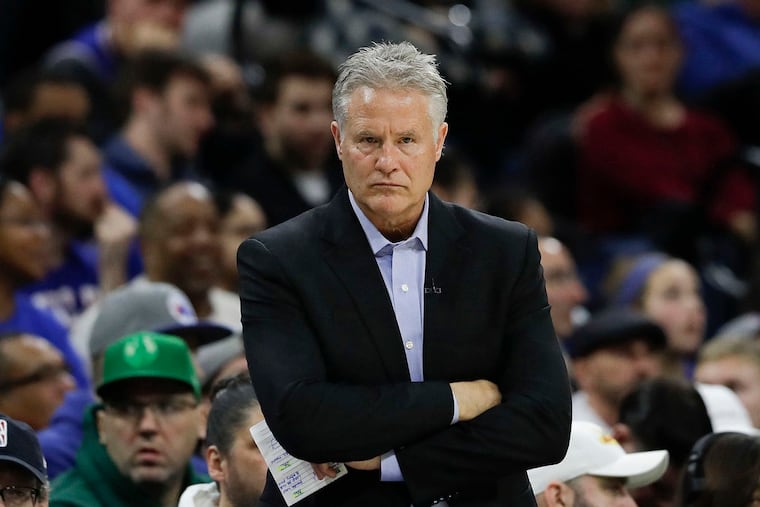Sixers shouldn’t fire Brett Brown: He’s been the glue to this team, not the problem | Bob Ford
For the Sixers, putting the blame where it doesn’t belong would be anything but a change. That would be business as usual for a franchise blind to its own organizational weaknesses.

If the 76ers were to fire coach Brett Brown, as my friend and colleague Marcus Hayes suggests, the first thing to understand is that Brown will be just fine. At 59, with seven seasons of NBA head coaching experience on his resume, decent money in the bank, and a clear conscience regarding the job he has done, it wouldn’t be surprising if Brown used the change as an opportunity for a lifestyle detour.
He could get another NBA job quickly, I’m sure of that. Any general manager taking note of how professionally Brown navigated the uncharted lunacy here since 2013 would be eager to snap him up. What challenge exactly could a franchise pose that Brown hasn’t already seen?
That might not be his path, though. This isn’t a guy afraid of change and new direction. After college and one year as a grad assistant for Rick Pitino, he took a sales job with AT&T, but only until he saved enough money for a backpacking trip to Fiji, Australia, and New Zealand. The trip turned out to last the better part of 15 years. Brett Brown is able to adapt. Maybe he’ll just fish. He likes to fish.
So, I agree with Marcus. Parting ways with Brown would provide a fresh start, but it would be for the coach and not the team.
For the Sixers, putting the blame where it doesn’t belong would be anything but a change. That would be business as usual for a franchise blind to its own organizational weaknesses and utterly incapable of demanding accountability from its players.
If Brett Brown had a failing here, it is that he was too good a human being to put himself first among the selfish lot that shared his desire for the common good only when it was in their best interests as well.
Any time there was something really difficult to explain to the public — and that was a whole lot of times — it was Brown left holding the bag. What’s with Joel’s foot? Why was Jahlil going 108 miles per hour over the Ben Franklin Bridge? Is Markelle having a breakdown? Ben Simmons really doesn’t listen, does he? Yes, that would be Brown up there explaining why it all made sense.
Well, good luck with the next guy. If you think it was a circus up until now, wait until you see how it comes apart without the glue.
All of that is the off-the-court qualities Brown has brought, and those are important. His loudest detractors, however, don’t think he can coach at all, and that is entirely unfair.
If you toss out the three years of tanking under Sam Hinkie, a collective 47-199 experience, and the 28-54 transition year under Bryan Colangelo, then Brown gets judged on the three playoff seasons that followed, including the one that is currently suspended.
The 52-win season in 2017-18 ended in a five-game conference semifinal loss to Boston. By the end, Joel Embiid was slow, sluggish and, as is characteristic, not in condition to play at his best. In the first three games of that series, all won by the Celtics, Simmons’ plus-minus was a combined minus-55. Jayson Tatum of Boston was a combined plus-35.
I don’t know exactly what Brown was supposed to do with that. They won in the regular season because Simmons was great in transition and early offense, but against an athletic team that could get back on defense, he became a half-court liability. The Celtics guarded only who they needed to guard, and that wasn’t Simmons.
Last season was actually several seasons, cut into pieces by the November trade for Jimmy Butler and the trade-deadline move to get Tobias Harris. A franchise-record 26 players took part in games for the Sixers before the regular season ended.
Brown did an excellent job of transitioning from the team that started the season to the one that finished it. In the playoffs, he made the remarkable move of taking Simmons off the ball and using Butler as an effective pick-and-roll point guard. Simmons, who had developed a decent post game by that time, was very good as a frontcourt offensive player.
If Embiid had been in better shape — where have we heard that before? — and if a four-bounce prayer of a shot hadn’t beaten them in Game 7 of the conference semifinals, a much better result might have taken place.
How did management build on what was learned last season? By tossing everything into the air again, naturally. The front office chose Simmons over Butler, redrawing the same point guard equation that hasn’t added up yet. It brought in Al Horford, a disastrous miscalculation. It failed to address the team’s need for three-point shooting to replace JJ Redick. It peopled the bench with a collection of lesser lights incapable of adding spark.
As Brown was trying to sort this out, he was without Embiid for 14 games since Jan. 9, without Josh Richardson for nine games since Jan. 25, and without Simmons for eight games since Feb. 20. The anticipated starting lineup of Embiid, Simmons, Harris, Horford, and Richardson was together for only 19 games. In all, there had been 12 players who started at least one game, including Kyle O’Quinn.
When the league came to stop after the games of March 11, the Sixers were 39-26, and still on the way to winning approximately 50 games once again. Fire Brown? The man should be Coach of the Year.
What he has done with the Sixers should be rewarded, not punished. Of course, getting fired might accomplish that. Having to stay with this bunch would be the real punishment.